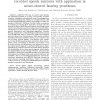Free Online Productivity Tools
i2Speak
i2Symbol
i2OCR
iTex2Img
iWeb2Print
iWeb2Shot
i2Type
iPdf2Split
iPdf2Merge
i2Bopomofo
i2Arabic
i2Style
i2Image
i2PDF
iLatex2Rtf
Sci2ools
CORR
2016
Springer
2016
Springer
EEG-informed attended speaker extraction from recorded speech mixtures with application in neuro-steered hearing prostheses
—Objective: We aim to extract and denoise the attended speaker in a noisy, two-speaker acoustic scenario, relying on microphone array recordings from a binaural hearing aid, which are complemented with electroencephalography (EEG) recordings to infer the speaker of interest. Methods: In this study, we propose a modular processing flow that first extracts the two speech envelopes from the microphone recordings, then selects the attended speech envelope based on the EEG, and finally uses this envelope to inform a multi-channel speech separation and denoising algorithm. Results: Strong suppression of interfering (unattended) speech and background noise is achieved, while the attended speech is preserved. Furthermore, EEG-based auditory attention detection (AAD) is shown to be robust to the use of noisy speech signals. Conclusions: Our results show that AAD-based speaker extraction from microphone array recordings is feasible and robust, even in noisy acoustic environments, and withou...
| Added | 31 Mar 2016 |
| Updated | 31 Mar 2016 |
| Type | Journal |
| Year | 2016 |
| Where | CORR |
| Authors | Simon Van Eyndhoven, Tom Francart, Alexander Bertrand |
Comments (0)

